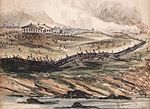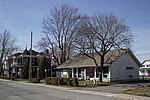Borduas
Quebec provincial electoral districts
Borduas is a provincial electoral district in the Montérégie region of Quebec, Canada that elects members to the National Assembly of Quebec. It notably includes the municipality of Beloeil, Mont-Saint-Hilaire and Otterburn Park. It was created for the 1994 election from Verchères and Iberville. In the change from the 2001 to the 2011 electoral map, it gained Saint-Antoine-sur-Richelieu, Saint-Charles-sur-Richelieu, Saint-Denis-sur-Richelieu, Sainte-Madeleine, Saint-Marc-sur-Richelieu, and Sainte-Marie-Madeleine from the Verchères electoral district. In the 1995 Quebec referendum it voted 58% for Quebec independence.
Excerpt from the Wikipedia article Borduas (License: CC BY-SA 3.0, Authors).Borduas
Geographical coordinates (GPS) Address Nearby Places Show on map
Geographical coordinates (GPS)
| Latitude | Longitude |
|---|---|
| N 45.648 ° | E -73.16 ° |
Address
Saint-Charles-sur-Richelieu
J0H 2G0
Quebec, Canada
Open on Google Maps











